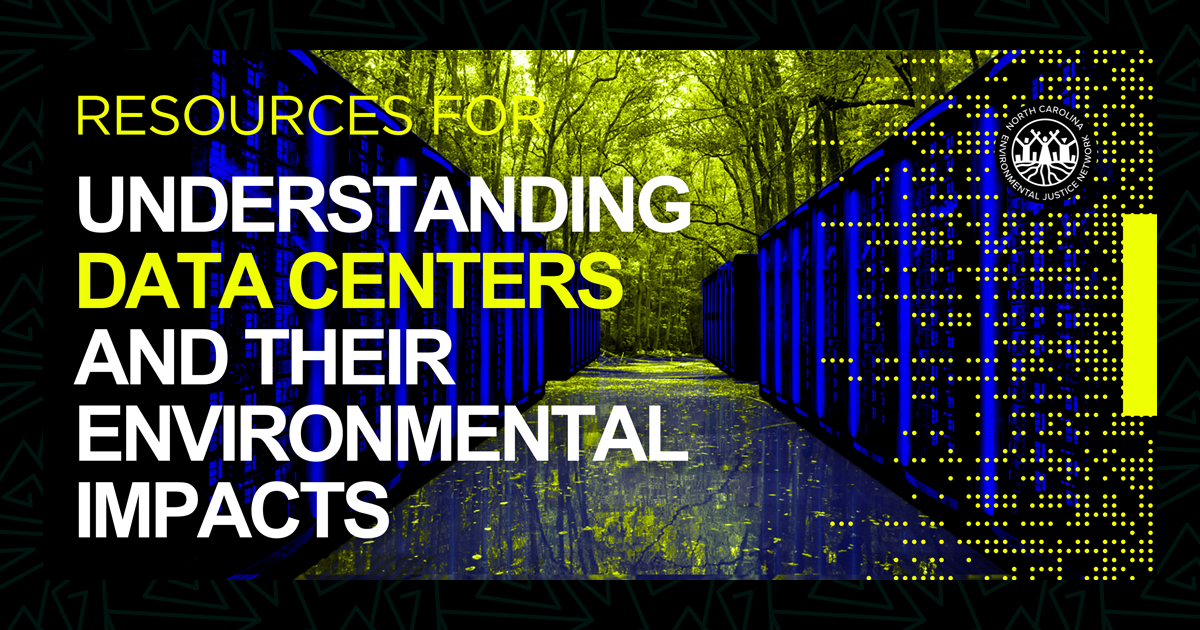Below you will find a number of resources that have been compiled over a couple of months for our NCEJN newsletter – please consider subscribing to learn more about the state of environmental justice in North Carolina, Nationally and Abroad, and the work that NCEJN does across North Carolina.
Here is the link for Four Pillars of Data Center Reform from the Piedmont Environmental Council.
VIDEOS:
– Video: The recording of the Webinar:Understanding Data Centers and Their Environmental Impacts
– Video: Hidden Costs of the Cloud: Data Centers in Virginia
– Video: “We Went to the Town Elon Musk Is Poisoning” Elon Musk’s massive xAI data center is poisoning Memphis.
EVENTS:- Cassandra and charla would like to invite you all to their upcoming gallery hours this month in June as well as an upcoming Artist Talk on the exhibit. You can find more information about those events below:
- Read:: “What Can A.I. Not Take from Us?”: An Interview With the Curators of Local Exhibition ‘Against the Machine’ – Indy Article piece written on the exhibit by Sarah Edwards
- Every Tuesday in July “Against the Machine” gallery hours: 2 – 6 PM. 1809 Chapel Hill Rd.Durham, NC 27707
– Webinar: AI Data Centers in Your Backyard: Who Is at Risk? The Center for Progressive Reform will explore how artificial intelligence (AI) requires the use of energy-intensive data centers. These facilities are forecasted to significantly increase global electricity demand. Some utilities in states across the country are building more fossil fuel infrastructure that directly contributes to climate change to account for this growing electricity demand. AI data centers also prompt questions around public and environmental health impacts, particularly in communities already overburdened by climate pollution. Tuesday, July 22 • 1:00 PM
ARTICLES:
Amazon in North Carolina
1.Amazon announced a massive $10 billion investment plan to expand its data center operations in North Carolina: Experts have warned of significant environmental challenges presented by AI data centers. Data centers of this scale typically require hundreds of megawatts of power—enough to supply a mid-sized town—and millions of gallons of water daily for cooling systems. Of the $10 billion investment, Amazon will commit to (a paltry) $150,000 for local community projects.
2. Amazon is planning 20 structures, each 250,000 square feet – in Richmond County. Land prices have already tripled in certain areas of the county.Data Centers and their costs to our communities:
1.Read: In race to attract data centers, states forfeit hundreds of millions of dollars in tax revenue to tech companies
2.Read: New study shows the environmental impact of chatting with AI
3.Read: Protect Yourself From Meta’s Latest Attack on Privacy
4.Read: Your AI prompts could have a hidden environmental cost
5.Read: AI Needs So Much Power, It’s Making Yours Worse
6.Read: The Silent Burden Of AI: Unveiling The Hidden Environmental Costs Of Data Centers By 2030
Resisting Data Centers 1.
Read: This rural community fought one of the country’s biggest gas-powered data centers — and won2.
Read: Local communities push back against hidden pollution from fossil fuel and AI sectors3.
Read: As Data Centers Proliferate Across Illinois, Communities Grapple with How to Supply the Necessary Water 4.
Read: xAI faces legal threat over alleged Colossus data center pollution in Memphis. NAACP demands a meeting to discuss xAI’s alleged pollution in Memphis 5.
Read: Rage against the AI
Business Insider Series on Data Centers:1.
Read: AI runs on dirty power – and the public pays the price2.
Read: Big Tech promised jobs, cities gave millions. Where are the millions? 3.
Read: How data centers are deepening the water crisis4.
Read: Tallying the true costs of AI
Summary of the Business Insider Series:
- Rise of data centers:
- Developers filed 4 times the number of permits for data centers in 2024 than in 2010 – resulting in the most significant surge in electricity demand since WWII.
- Amazon, Microsoft, Meta, and Google’s parent, Alphabet, said they’ll spend at least $320 billion this year on facilities and equipment, overwhelmingly for AI.
- 1,240 data centers in the US already built or approved for construction by the end of last year
- Impact on water:
- The largest data centers can guzzle millions of gallons of fresh water a day. Roughly 40% of those in the US are in the most water-stressed areas of the country.
- Data centers that do use water for cooling overwhelmingly rely on fresh supplies.
- In 2018, the industry was already one of the ten largest commercial or industrial water users in the US
- Impact on public health:
- The data center boom is undermining sustainable energy goals and driving $5.7 billion to $9.2 billion annually in public health costs from air pollution.
- Expected health impacts include between 190,000 – 300,000 asthma symptom cases and between 370 – 595 premature deaths each year.
- One in five data centers are in communities already overburdened by environmental pollutants
- Noise: Their punishingly noisy cooling fans run all day and all night – making it difficult for those who live near the data centers.
- Impact on jobs:
- Data centers, which operate largely autonomously, don’t produce many lasting full-time jobs. Even the largest data centers generally employ fewer than 150 permanent workers, and some have as few as 25.
- The construction jobs are short-terms, far shorter than the duration of the tax breaks the companies get, which often last a decade or longer.
- Tax breaks to developers can amount to more than $2 million for every permanent, full-time job; that’s 8 times higher than the $262,000 average per job found in 18 economic development deals worth $50 million awarded in 2023.
- Thirty-seven states (including NC!) have tax incentive programs for data center investments; most exempt developers from sales and use taxes on building materials, machinery or equipment – resulting in big hits to state coffers.
- When the costs of lost tax revenue and escalating electricity prices are factored against what the communities get in jobs and revenue, there is no evidence the city will benefit.
- Impact on energy costs:
- Consumption: Data centers draw power from the local utility grid – but, since they run 24/7, they rely on backup generators that burn diesel fuel or natural gas if the power goes out. Amazon tops the list! – If it builds all the data centers it has planned, it would use the same amount of electricity as the state of Nevada in 2023.
- Energy costs: Data centers’ power needs are large enough that they tend to raise local electricity bills for everyone.























